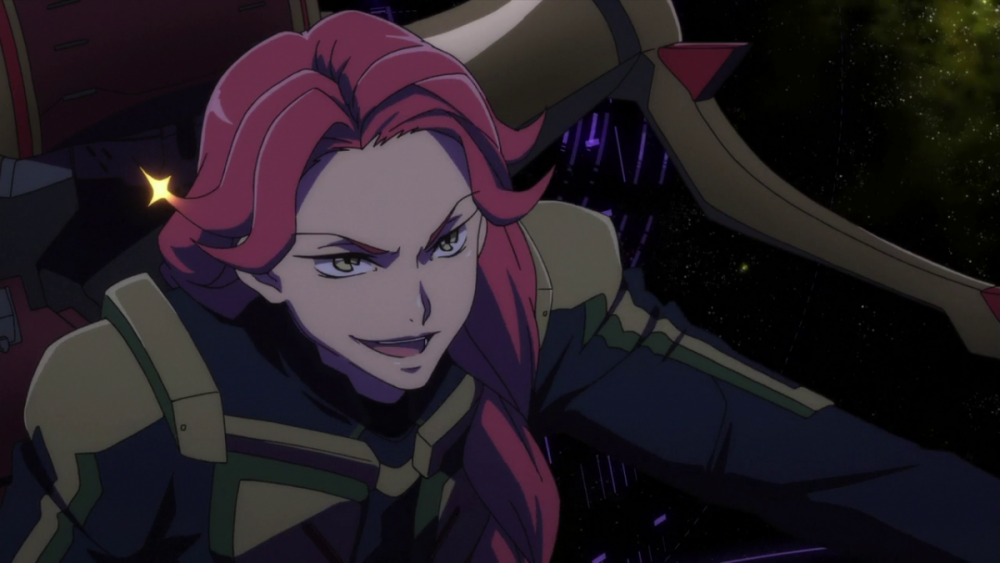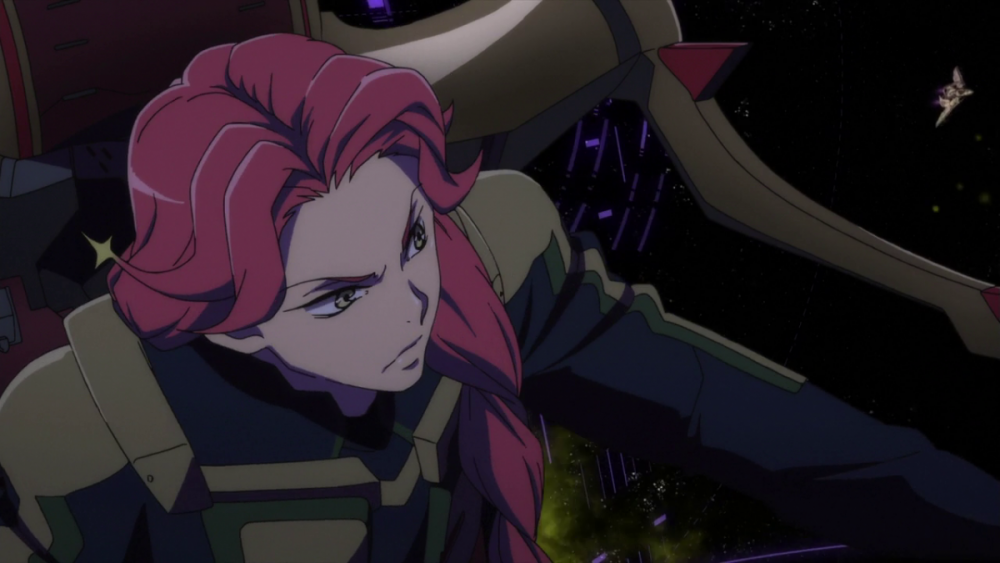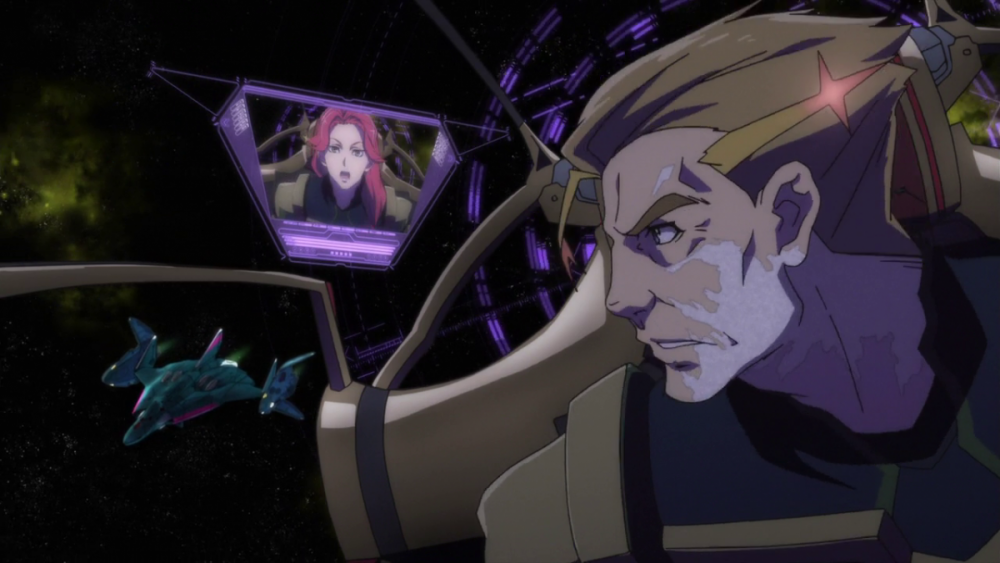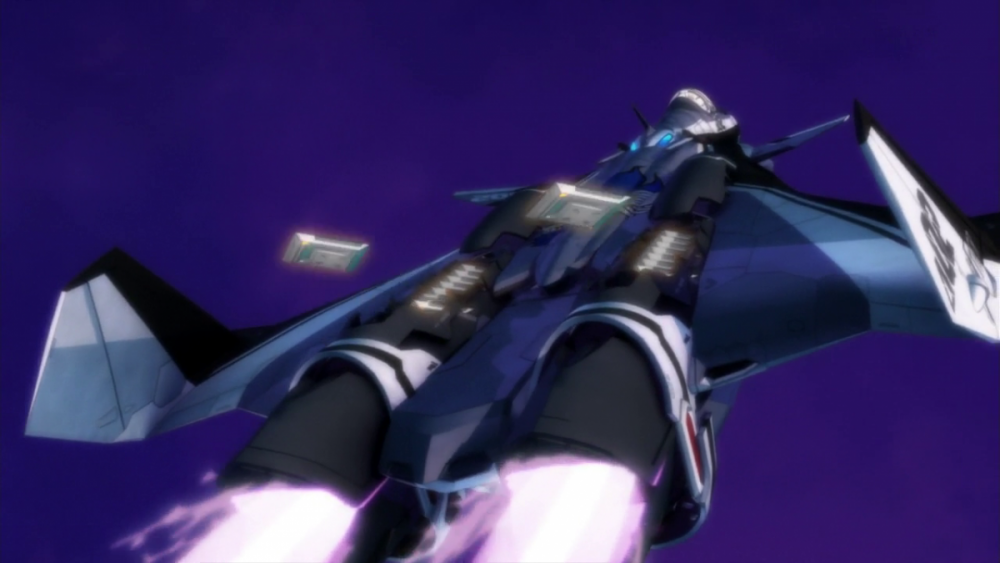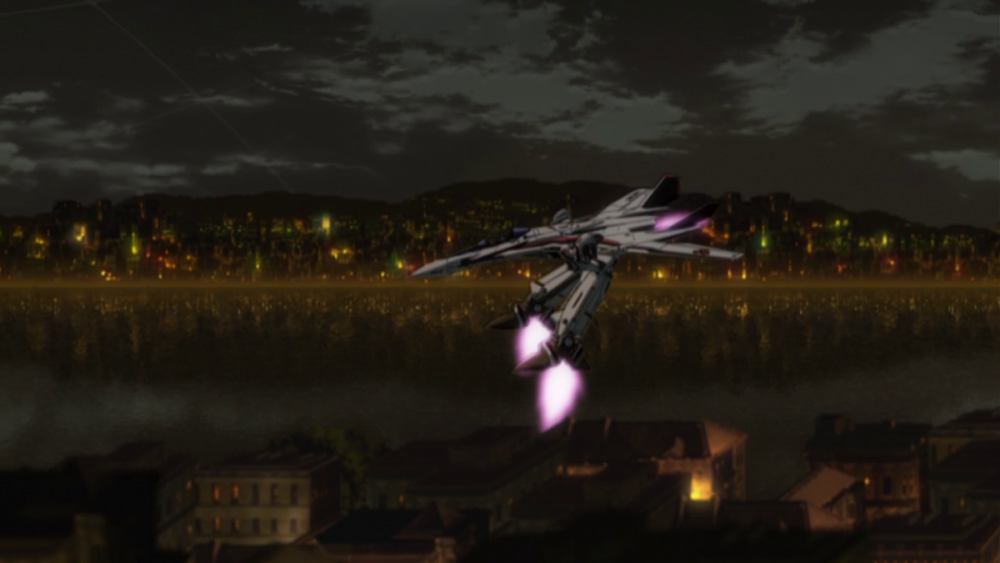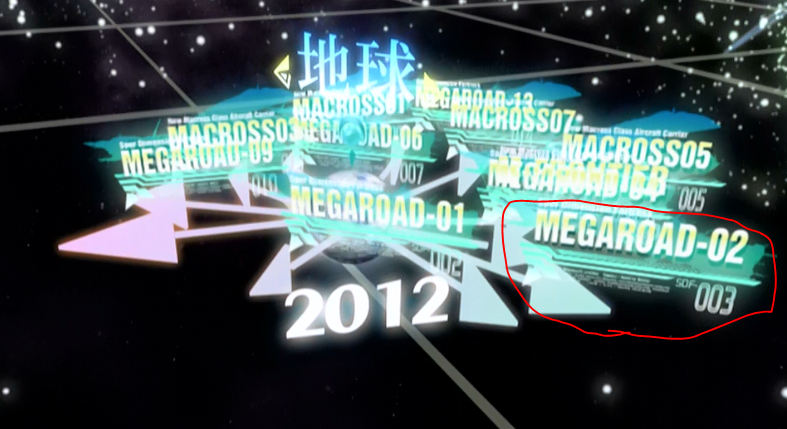-
Posts
13829 -
Joined
-
Last visited
Content Type
Profiles
Forums
Events
Gallery
Everything posted by Seto Kaiba
-

Macross Δ (Delta) Mecha/Technology Thread - READ 1st POST
Seto Kaiba replied to azrael's topic in Movies and TV Series
Yes, really. It's the mecha that Mikumo jumps onto. It has the distinctive canisters on the back of the right shoulder and a back-mounted impact cannon. Really, it's inevitable that their fighter would have to have a YF-29/YF-30 grade ISC, otherwise the VF-31 would absolutely eat it alive. As far as where they got the fold quartz... there are a LOT of possibilities there. -

Macross Δ (Delta) Mecha/Technology Thread - READ 1st POST
Seto Kaiba replied to azrael's topic in Movies and TV Series
My money's on modern variations... the UN (later New UN) Government has had an Esbeliben automated factory satellite in orbit of Earth for a good 55 years now, so they've had plenty of opportunity to come up with their own improved versions of Zentradi mecha with which to outfit the Zentradi forces in the (N)UNS Marines. There's a Queadluun-Rhea mixed in with the Var syndrome-induced rogue troops in the episode, so it seems likely they're operating human-designed variations of traditional Zentradi mecha. Considering the Sv-262 has demonstrated several capabilities in common with the YF-29 already, my guess would be that they've gotten their hands on the YF-29's specs and developed their own fighter based on them (with the YF-29's improved ISC). (We do know, via Macross the Ride, that the YF-29 spec was leaked by LAI nine or ten years before the events of Macross Delta, which definitely makes it plausible.) -

Macross Δ (Delta) - NYE Special Talkback - READ 1st POST
Seto Kaiba replied to azrael's topic in Movies and TV Series
Well, she was highly popular (and perfectly legal) right up to the point where Marj went and installed an illegal/restricted bioneural processor in her that made her self-aware. (I vaguely recall reading something about virtuoids being not-uncommon in the wake of the Sharon Apple incident, but they're all restricted to the "all flash and no substance" non-interactive/non-learning type by law.) They had colonies on the moon and space colony clusters at the Lagrange points too... so I'd wager a lot of stuff probably survived. The familiar-looking cars could also potentially be excused by the fact that the entire Macross Frontier emigrant ship is basically a huge, deliberately retro recreation of various areas from prewar Earth (San Francisco, Shibuya, etc., allegedly for psychological reasons), and that dedication to the prewar Earth aesthetic may have carried over to the automobile designs on offer in the fleet. Though I'd expect the resemblance to modern cars is probably superficial... the one car we see up close (Ozma's replica Lancia Delta HF Integrale Evoluzione, circa 1992!) has visible vernier thrusters and other bits of hardware that were definitely not available on the original, and is likely using a hydrogen engine like the cars in DYRL? for low emissions. (Or it may be battery-electric or using a fuel cell.) -

Macross Δ (Delta) Mecha/Technology Thread - READ 1st POST
Seto Kaiba replied to azrael's topic in Movies and TV Series
She says "一〇四式リガードちゃん" Literally "Type One Zero Four Regult-chan". (Yes, she is reading the digits individually... if she'd said "Type One Hundred and Four Regult-chan" it would've been 百四式リガードちゃん.) -

Macross Δ (Delta) Mecha/Technology Thread - READ 1st POST
Seto Kaiba replied to azrael's topic in Movies and TV Series
As I see it, there are three potential explanations for the glow around the members of Walkure, in what I feel is a descending order of likeliness. Artistic license - Kawamori and co. just want the songstresses of Walkure to be highly visible to the audience against busy and/or dark backgrounds. It's holographic - the way the members of Walkure each have an aura surrounding them in a color that matches each member's dominant color is a consequence of the active holographic projections used for their costumes and backup dancers on the microdrones. It may also be intentionally calculated to increase the visibility of Walkure members, as above, because they perform in the combat area... which is seldom a high-visibility environments. It's a fold aura - we saw something similar in the shared mindspace where Ranka cured Sheryl's v-type infection in the finale of Macross Frontier, which makes it potentially possible that the auras surrounding the members of Walkure is a visible manifestation of their biological fold waves (probably as a result of mechanical amplification of those fold waves like what Dr. Chiba produced with the song energy amplification for Sound Force). This might explain why the aura is occasionally absent when the singers are interrupted during their performance. I doubt it's a manifestation of a practical, defensive technology... if it were, they wouldn't need the microdrones to generate barriers. Yeah, I've been working with a material scientist at my day job to suss out how, exactly, energy conversion armor might be using electromagnetic pulses to improve its resilience. We've got two working theories on it right now based on its apparent nature as magnetostrictive: That the electromagnetic pulses are acting on the structure of the laminate component of the armor, such that its rigidity is increased until mechanical stresses exceed a certain level... at which point it returns to its elastic state to dissipate the impact energy across a larger area. (Making it sort of a magnetically-triggered shear thickening response... the armor's laminate layer gains viscosity when exposed to the EMP, and experiences localized loss in viscosity when the magnetic response is changed by an impact so that the more liquid pseudo-plastic can disperse the energy over a wider area, as the plastic layers in bulletproof glass do.) That the electromagnetic pulses are acting on the structure of the composite component of the armor, in a way that the armor is becoming more elastic and behaving like a magnetic shape memory material... allowing it to reversibly deform slightly under impact and regain its original shape, allowing it to displace more energy into the laminate layer without a fracture occurring. -

Macross Δ (Delta) Mecha/Technology Thread - READ 1st POST
Seto Kaiba replied to azrael's topic in Movies and TV Series
Yes, I know what the M3 Macrosspedia entry says (because I helped write it). The way it's described in Chronicle, the laminate's a component part of the armor, rather than a separate substance applied to the armor. Something like the plastic layers in bulletproof glass or the elastic layers in Chobham armor. -

Macross Δ (Delta) Mecha/Technology Thread - READ 1st POST
Seto Kaiba replied to azrael's topic in Movies and TV Series
The energy conversion armor technology isn't "boosting" armor... it is the armor. As explained by Macross Chronicle, the energy conversion armor is a type of layered, laminated overtechnology armor material that becomes more resilient when subjected to specific types of electromagnetic pulse. It's so named because excess energy from a Valkyrie's engines is converted into increased armor strength... and it requires a LOT of juice to achieve results. -

Macross Δ (Delta) Mecha/Technology Thread - READ 1st POST
Seto Kaiba replied to azrael's topic in Movies and TV Series
Considering that holographic costumes have already been the standard for at least eight years by this point, and that we've seen the technology is easily able to change the appearance of a person's hair as well, if Mikumo's hair isn't simply handwaved as artistic license then it's highly probable that it's a special effect that's being applied courtesy of the holographic costuming. (As a longshot, the ridiculously long hair may not even be her real hair... it could be a simulation or a mobile fiber wig of some kind.) Oh sweet machine god, did I just postulate the existence of the cyber-weave? I think can handle any of the above possibilities... as long as the men from Windermere don't start squealing with girlish glee and spraying theatrical glitter all over hell's half-acre the way Freyja was. Actually, same scene as before... the wings rotate 180 degrees along the seam visible in the wing so that the wing edges touch. That's how they form the square. -

Macross Δ (Delta) Mecha/Technology Thread - READ 1st POST
Seto Kaiba replied to azrael's topic in Movies and TV Series
Actually, we've already seen the pretty flyboys (and their not-so-pretty leader) start lighting up... it definitely seems to coincide with the individual's mood (most likely excitement). -

Macross Δ (Delta) - NYE Special Talkback - READ 1st POST
Seto Kaiba replied to azrael's topic in Movies and TV Series
Not sure that "jamming" is the right word for it. Walkure seems to combat Var syndrome by using an externally-generated fold wave (via song) to correct some kind of imbalance in a person's natural (biological) fold waves. At this point it's not really explained whether Var syndrome is a communicable disease, or some form of adverse reaction to certain types of fold waves (like a super dimension allergy?), but whatever outside agency is manipulating Var syndrome for its own ends is definitely either causing the syndrome or at least exacerbating the symptoms with some manner of inimical fold wave/song. At this point, Macross seems to have established a relationship between living beings and super dimension space not dissimilar to living beings and the warp in Warhammer 40,000. The mental or emotional states of living beings seem to have a measurable presence in super dimension space as fold waves, which apparently can be affected by outside sources. Mechanical amplification and transmission is apparently also possible, as Chronicle suggests that spiritia and song energy are a form of fold wave as well. Var syndrome would seem to be a physical manifestation of an attack on a person's ethereal/mental body in fold space. On that basis, it seems that Walkure is effectively Sound Force 2.0... a unit of people who can (consciously or not) manipulate the polarity of their natural fold waves (making them Anima Spiritia) and, with appropriate assistance, broadcast them at other people to achieve various effects. (Sheryl and Ranka may also be capable of this, but they seem to be a somewhat special case... since their bodies were modified via the v-type infection to broadcast a particular type of fold wave other than their natural one (the zero-time fold waves the Vajra use for communication). -
Nothing of significance at this time, no.
- 800 replies
-
- discussion
- variable fighters
-
(and 1 more)
Tagged with:
-
Duly noted, thanks for confirming that guys! (... aaaaand order placed!)
-
I get nothing on the title "Great Mechanics - Summer G". Poss. Great Mechanics G 2015 Summer?
-

Does somewhat unrealistic mecha controls ruin the fun for you?
Seto Kaiba replied to JLYC's topic in Movies and TV Series
The thrusters are visible on the cutaway in Variable Fighter Master File: VF-25 Messiah, but are not specifically called out in any section of the book that I can find. Unless it's capable of thrust-vectoring like practically every vernier in Macross... I don't recall seeing anything like that, no. -

Does somewhat unrealistic mecha controls ruin the fun for you?
Seto Kaiba replied to JLYC's topic in Movies and TV Series
Bingo... the arm with the weapon was responding to the optical pointing system incorporated in the helmet. I got you a picture (from Macross Frontier Ep2) that shows the VF-25 in GERWALK burning its backpack engines. The YF-21/VF-22 has additional nozzles in the feet... it's just the main nozzles that migrated to the backpack. -

Does somewhat unrealistic mecha controls ruin the fun for you?
Seto Kaiba replied to JLYC's topic in Movies and TV Series
You'd probably get a kick out of Dai-Guard then... it's a send-up of super robot tropes, and one of them is that the giant robot the private security company in the show bought secondhand from the military is interface hell for its three-man crew. (They have a crew member whose sole job is to manage the damn thing's transmission.) Though, really, Macross has taken a relatively Gundam-inspired take on mecha controls... the pilot's only really specifying direction, velocity, and posture. It's the computer that's turning those joystick waggles, button presses, and pedal pressures into something approximating human movement. They aren't controlling the motions of the robot directly, they're just giving approximate input to the motion management software that controls the actuators and auto-balancer, which takes all that data and converts it into the physical motions of the robot. I doubt it. The VF-31 has been shown in the trailer to have a fairly traditional cockpit (with EX-Gear, as on the VF-25). The Sv-262 might have a cyber-cockpit like the VF-27. The kind of agility these mecha exhibit would be straight-up impossible if they weren't using a control system that had been greatly simplified for the operator. Take a gander at Dai-Guard or Patlabor for a good look at how clumsy robots get when the operator's got to worry about four hundred different levers, switches, pedals, and so on. The VF-1 never had brainwave sensors... that technology first appeared on the YF-21 prototype, was relegated to a backup system on the VF-22, and only finally adopted as a primary means of control via direct cybernetic interface on the VF-22HG and VF-27. Only when the VF-25 is being controlled externally by a suit of EX-Gear (Connect-Slave mode). When the EX-Gear is mounted in the cockpit, it forms a traditional set of controls. -
OK. Kept short and sweet, both thermonuclear reaction power systems and thermonuclear reaction weaponry use the exotic, super-high mass matter known as heavy quantum (heavy quanta?) to catalyze and control the reaction. Heavy quantum's mass is so obscenely huge that, in sufficient quantities, it'll crush itself so hard it'll auto-ignite in a fusion reaction when subjected to the physics of the three-dimensional universe. This effect is what's used to moderate and catalyze the reactions inside of reaction engines, and as a substitute for the fission trigger in thermonuclear reaction weaponry. In power generation systems, I suspect that's being exploited to allow the reaction furnace to sustain itself on the proton-proton chain reactions normally found inside stars... which would increase the energy yield of the hydrogen fuel about 21.2x over just fusing the hydrogen and stopping there. IMO, there are two possible explanations for why a thermonuclear reaction warhead might leave behind some radioactive byproducts. Either they're using some other overtechnology to catalyze the fusion reaction instead of heavy quantum, or they're not using enough heavy quantum to bring the higher-dimension spatial physics into play and thus the reaction is producing a fair amount of gamma radiation in addition to the enormous release of heat.
- 7106 replies
-
- newbie
- short questions
- (and 22 more)
-
Like JB0 said, the pair-annihilation (antimatter) reaction warheads were a later innovation... circa Macross 7. (It doesn't look like pair-annihilation reaction weapons ever actually replaced thermonuclear reaction weapons outright... they seem to just be one megadeath nastier, for foes who have it coming. Most of the reaction warheads in the Macross series appear to be of the thermonuclear type, which use the same extradimensional physics as reaction power systems and Macross Cannons to produce vast amounts of heat energy from a fusion-like reaction.) Macross Chronicle's Technology Sheet 09A "Reaction Weapons" indicates that the initial models of reaction warhead that were used during the Unification Wars did have the potential to create some residual radioactive effects. They don't say why, but the issue was apparently solved when they built later models of reaction warhead that were used in the First Space War and after. (I have a physics-based theory about why there might be residual radioactivity, but it's purely speculative.)
- 7106 replies
-
- newbie
- short questions
- (and 22 more)
-
Technically, 13 "and a half". There's the initial, converted Supervision Army warship (SDF-1), the unfinished SDF-2 that was converted into the first Megaroad-class emigrant ship, and then the twelve postwar "mass-production" Macross-class ships (SDFN-1 thru 12) modeled on the SDF-1 Macross's design. I say "mass production" in slightly sarcastic quotes because, according to Macross Chronicle1, each production type SDFN is unique because they were constructed in part with systems taken from scrapped Zentradi warships. For convenience's sake, I suppose they're probably collectively the Macross-class. No, based on what's seen in Macross Frontier and said in Macross Chronicle2, the hull classification symbol "SDF" was passed to the Megaroad-class emigrant ships starting with the SDF-2 Megaroad-01 in 2012. SDF-3 was Megaroad-02, and so on. The 12 production Macross-class ships were given the hull symbol "SDFN" and started over from 1. (So far, we have had mention of the SDFN-1 General Hayase, and seen the SDFN-4 General Bruno J. Global and SDFN-8 General Vrlitwhai Kridanik.) Yes, the SDF-2 Megaroad-01 was the first ship of the Megaroad-class, at least 25 of which were laid down at various shipyards in the Sol system. (No exact number is given, and as Macross Chronicle says a "great number" were built, there may be more than one per emigrant fleet at times as there were with some New Macross-class emigrant fleets like Macross-1 and Macross-5.) The production Macross-class ships were supposedly used as advanced reconnaissance ahead of the early emigrant fleets, and some were seconded to other operations (like the SDFN-4's assignment to the ill-fated 117th Research Fleet) after their emigrant fleets found new homes. Others, like SDFN-8, apparently were retained by the emigrant fleets after settlement... SDFN-8 having become "Vrlitwhai City" on Uroboros by 2060. 1. Technology Sheet 06A. 2. Worldguide Sheet 12C.
- 7106 replies
-
- newbie
- short questions
- (and 22 more)
-
Macross II's director Ken'ichi Yatagai dropped a few hints that were leading in that direction in B-Club Magazine Vol.79's feature on the OVA, but nothing that's particularly definitive. The Mardook are an ancient miclone group with males and females coexisting, who regard their culture as sacred, and their technology surpasses that of the Zentradi and Meltrandi. Considering the state of the setting at the time of writing, it's at least not improbable that the Mardook were the descendants of another group of Protoculture who fled their civilization's collapse and tried to start over. Of course, as Macross II is a "parallel world" story, the yardstick for identifying the Protoculture is somewhat different. They're only "advanced aliens" rather than the "sufficiently advanced aliens" that they seem to have graduated to around Macross Zero.
- 11 replies
-
- Macross II
- Manga
-
(and 1 more)
Tagged with:
-
Okay, there are a couple issues with that... What Master File calls the ARMD II-class are the Do You Remember Love?-style ARMDs. The rebuilt SDF-1 Macross and the twelve new Macross-class SDFNs were always equipped with that type. The new ARMD I and ARMD II docked to the Macross were among the very first ships of that type built in the main continuity. Master File isn't entirely reliable on this, as it forgets that little detail and its version mentions the ARMD II-class as something much newer, cropping up around the time the ARMD's hull numbers reached 200+. There's no indication that the ARMD-class (TV type) were sent out and then recalled in official sources. We have no idea how many were built of each type before the classes was phased out of production in favor of the newer Uraga-class escort battle carriers and the Guantanamo-class Advanced ARMDs. There are still several TV series-type ARMD-class space carriers kicking around in some stories set in the 2040's (e.g. Macross 7 Trash and the game version of Macross Plus). We also see that they were still using some ARMDs in emigrant fleets including the Macross-1 fleet seen in the opening exposition of Macross 7. With respect to the ship in the Macross Delta trailer... it's obvious at a glance that it's a Macross Quarter-class variant. All that's changed is they rounded off a lot of the points (like the front of the torso and pelvis) and stuck one or two extra guns on it. The configuration of the torso block, the shoulders, the head, the BASTER-L and BASTER-R battery ships on the back... look at the closeup 34 seconds in.
- 7106 replies
-
- newbie
- short questions
- (and 22 more)
-
Nah, the VF-1D Valkyrie isn't any taller in battroid than any other variant of the VF-1 Valkyrie. Stonewell/Bellcom didn't really make the VF-1D's cockpit block all that much larger, they made room to extend the canopy and add the second seat by taking a good deal of equipment out of the back end of the cockpit block and seating it a little further back in the airframe. Some Macross sources (like Macross II's VF History piece in B-Club 79 and the main timeline's Variable Fighter Master File: VF-1 Valkyrie Vol.1) assert that the reason the VF-1D was swiftly replaced by a dedicated training variant (the VT-1) was that one of the systems compromised to make room for the instructor seat was the escape/survival system... so they couldn't be safely used as training aircraft in space.
- 7106 replies
-
- newbie
- short questions
- (and 22 more)
-
The original (pre-FB2012) rationale for the SDF-2 was that it was constructed at a shipyard on the moon to be the second Macross-class space battleship in the UN Spacy's fleet. It was dubbed Megaroad when construction on the ship resumed after the end of the war, and with the announcement of the Human Emigration Project it was retasked to serve as an ad hoc emigrant ship. Had it been animated as planned in the original Macross series, the SDF-2 Megaroad would've still been a Macross-class military vessel when it was completed, and would've been retrofitted with civilian living space like the SDF-1 Macross was. The bit about the SDF-2's design being modified into the first of a new class of emigrant ships was a later addition to the timeline. The DYRL?-style SDF-1 Macross in Flashback 2012 is supposed to be the SDF-1 Macross... nothing more, nothing less. There wasn't a concrete view of which version of the First Space War was the correct one at the time Flashback 2012 was made. That didn't occur until Macross II and Macross Plus came out, with Macross II treating DYRL? as the more accurate of the two and the supplemental materials that came out with Macross Plus establishing DYRL? as an in-universe movie. The explanation that would ultimately be given for the DYRL? SDF-1 in Flashback 2012 and Macross Plus was that that's what it ended up looking like after the eight month complete overhaul it underwent to repair the damage it had sustained during both the final battle of the First Space War and Quamzin's suicide attack. The ARMD-class space carriers that replaced the naval carriers were simply part of the overhaul... and the Macross had (in-universe) always been intended to have ARMDs for arms anyway. That was my thought as well... that DYRL? was likely filmed using one of the Macross-class SDFNs. It doesn't necessarily need to be the SDFN-01 General (Takeshi?) Hayase, since they could always change the hull number temporarily the way Star Trek IV did when the USS Ranger (CV-61) stood in for the USS Enterprise (CVN-65). They would've had twelve to choose from.
- 7106 replies
-
- newbie
- short questions
- (and 22 more)
-
Yes, I'm sure. The original animation in Macross Flashback 2012 was the realization of a set of scenes that had originally been included in the final episode (#36) of Super Dimension Fortress Macross, but were removed in the storyboard phase to keep the episode from exceeding its allotted run time. Ultimately, that meant that the SDF-2 design they created for that episode (see Macross Perfect Memory pg150) went unused and a new design was subsequently created for Macross Flashback 2012, which is the Megaroad-class emigrant ship design. Because Flashback 2012 incorporated some DYRL? aesthetics like the Macross w/ ARMDs, and because it was produced after DYRL?, it tends to get rolled into DYRL? as an epilogue even though it's really more an epilogue to the entire First Space War story arc (and was conceived as an epilogue to the original series).
- 7106 replies
-
- newbie
- short questions
- (and 22 more)

